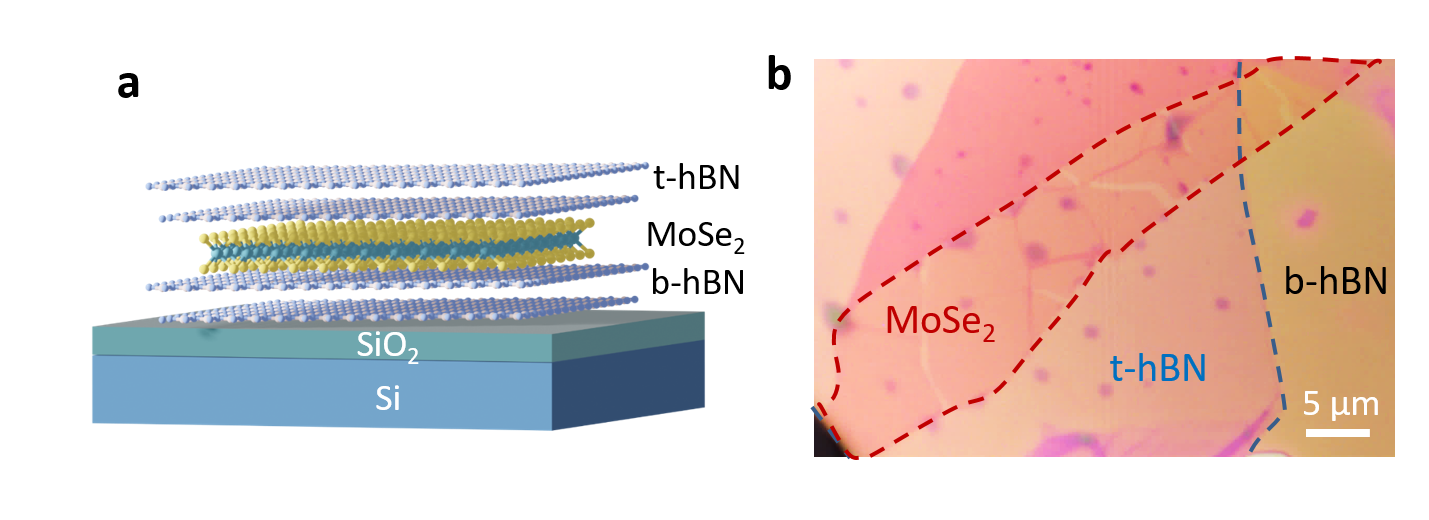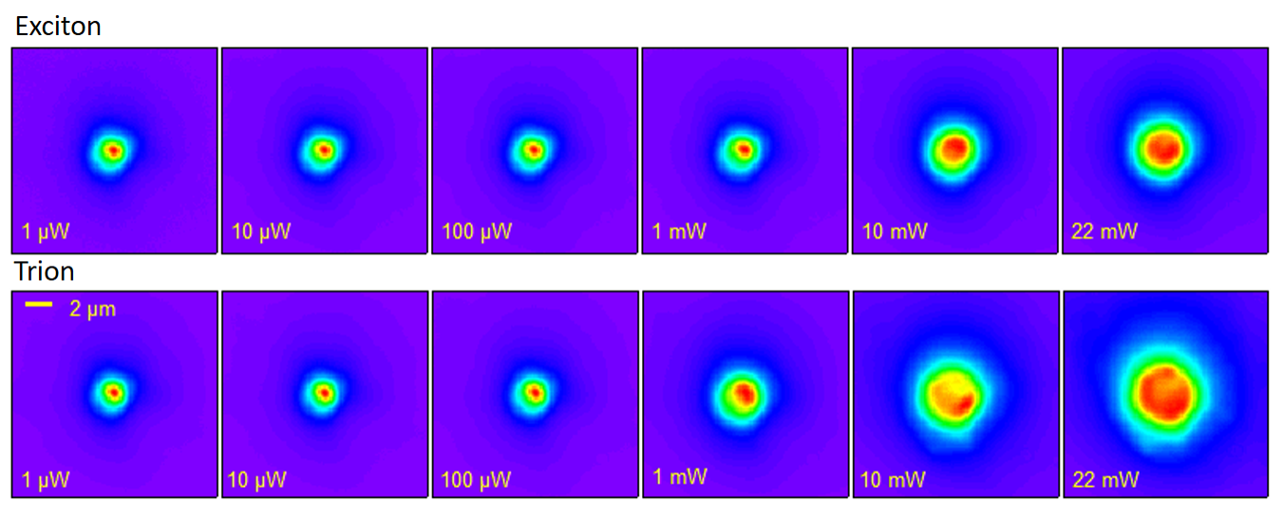A recently published work from the “Electrons Photons Surfaces” group explores the peculiar transport properties of excitons in novel, atomically thin 2D semiconductors.
A polarized hyperspectral microscope developed at PMC was used to measure the behavior of photo-generated excitons under a strong laser excitation. The laser creates an inhomogeneous local heating of the 2D crystal, which in turn pushes charged excitons away from the excitation spot (Seebeck drift). These findings have been published in the prestigious journal 2D Materials.
Transition metal dichalcogenide (TMDC) monolayers such as MoS2, WSe2, MoSe2 and WS2 are a new class of two-dimensional (2D) semi-conductors with an enormous potential for a wide variety of applications such as flexible and ultrathin electronics and opto-electronics. In addition, due to the particular bandstructure and broken inversion symmetry in these atomically thin crystals, the spin and valley (momentum) degrees of freedoms of electrons can be easily manipulated by light. This could allow for the storage and processing of information via the valley and/or spin index of carriers in these ideal 2D systems.
Another striking feature of these 2D semiconductors is the very strong Coulomb interaction between carriers. Electrons and holes form tightly bound pairs, or excitons, with binding energies of the order of several hundred meV, thus orders of magnitude larger than the ones found in traditional semiconductors such as gallium arsenide or silicon. Because of this strong binding, in these materials excitons are stable even at room temperature. This opens the door for a variety of applications aiming to exploit the exciton’s properties in novel devices. For example, due to the strong light-matter interaction inherent to tightly bound excitons, efficient coupling between optical data transmission and electronic processing systems may be achieved. Therefore, a better understanding of the transport of excitonic particles is required for the development of future technologies based on the excitonic properties of TMDC MLs and their heterostructures.
Figure 1 (a) Schematic drawing of the sample. The MoSe2 monolayer is encapsulated between two thin h-BN flakes to provide high optical and transport quality. Here, t-hBN and b-hBN stands for top and bottom hBN, respectively. The whole heterostructure is deposited onto a silicon substrate with a 80 nm oxide layer. (b) Optical microscope image of the sample.
Very recently, room temperature experiments investigating the temporal and spatial dynamics of the excitonic photoluminescence (PL) under pulsed laser excitation have revealed the appearance of a halo in the PL’s spatial distribution at high fluence. This has been attributed to the drift of excitons driven by an effective temperature gradient. Indeed, a strong and focused laser excitation generates an inhomogeneous distribution of hot carriers. Their subsequent relaxation is at the origin of an inhomogeneous lattice and carrier temperature which in turns pushes excitons out of the excitation spot via the Seebeck effect.
In this work, we bring new elements for a better understanding of this phenomenon by simultaneously measuring the spatial dynamics of excitons and trions in ML MoSe2 using hyperspectral imaging at cryogenic temperatures. In contrast with previous studies, here we use continuous laser excitation, either above or at resonance with the neutral exciton transition. In addition, we have used encapsulation by hexagonal boron nitride (hBN) to study fully protected MLs (Figure 1). This technique provides linewidths of both exciton and trion peaks close to the homogeneous limit at low temperatures, thus allowing for the clear separation of both excitonic complexes and the study of their propagation in the presence of a common temperature gradient. We show that the thermal drift is responsible for the appearance of a halo on the trion’s spatial distribution, which is barely visible under the exact same conditions for the exciton distribution due to its much shorter lifetime, as shown in Figure 2.
Figure 2. Photoluminescence’s spatial distribution of excitons and trions for selected excitation powers. At high powers, the trion distribution develops a halo at the center. The images have a lateral size of 14 µm
This halo was only observed so far under pulsed laser excitation at room temperature. Hyperspectral imaging permits a measurement of the trion temperature as a function of space and confirms the existence of a strong temperature gradient at high excitation. The results are consistent with the following simple picture : photons generate hot carriers which diffuse over typically one micron before relaxing their energy and convert into either cold excitons or trions. This energy relaxation creates a temperature gradient which extends across the hot carrier distribution. Excitons and trions then drift under the presence of this temperature gradient, which dominates over diffusion. Finally, we have shown that this halo can be observed under resonant excitation of the neutral exciton, which can be explained by the fact that resonant exciton-exciton interactions creates hot excitons, thus mimicking the effect of an off-resonance excitation.
This work, done in collaboration with the LPCNO (Toulouse) and the NIMS (Japan), is a step towards a more detailed understanding of the different physical phenomena that can govern excitonic transport at high excitation densities.
Publication
Imaging Seebeck drift of excitons and trions in MoSe2 monolayers, S. Park, B. Han, C. Boule, D. Paget, A. Rowe, F. Sirotti, T. Taniguchi, K. Watanabe, C. Robert, L. Lombez, B. Urbaszek, X. Marie and F. Cadiz, 2D Materials 8, 045014 (2021).




